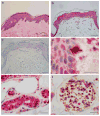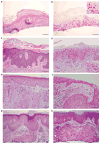Soluble adenylyl cyclase defines a nuclear cAMP microdomain in keratinocyte hyperproliferative skin diseases
- PMID: 20130594
- PMCID: PMC3082439
- DOI: 10.1038/jid.2009.440
Soluble adenylyl cyclase defines a nuclear cAMP microdomain in keratinocyte hyperproliferative skin diseases
Abstract
Cyclic adenosine monophosphate (cAMP) is a nearly ubiquitous signaling molecule important for numerous signaling pathways in human skin. We studied a novel class of mammalian adenylyl cyclase, the soluble adenylyl cyclase (sAC). We examined sAC localization in normal human skin and found it to be present in keratinocytes, melanocytes, mononuclear cells, eccrine ducts, and nerves. In normal skin, sAC keratinocyte staining was evenly distributed throughout the cell. However, in certain hyperproliferative disorders of the skin, including psoriasis, verruca vulgaris, and SCCIS on sun-damaged skin, sAC keratinocyte staining was predominantly nuclear. In contrast, in other hyperproliferative disorders, such as basal cell carcinoma, sAC staining was similar to normal human skin. Using a model of epithelial differentiation, we established that sAC migrates into the nucleus when differentiated cells are induced to reenter the cell cycle. Previous work had determined that nuclear sAC activates the cAMP-response-element-binding (CREB) transcription factor, and we found that in psoriasis lesions, nuclear sAC occurs concomitantly with activation of CREB. Hence, sAC may play a role in the pathogenesis of certain hyperproliferative skin disorders via modulation of gene expression.
Conflict of interest statement
The authors state no conflict of interest.
Figures





References
-
- Abdel-Malek ZA, Knittel J, Kadekaro AL, et al. The melanocortin 1 receptor and the UV response of human melanocytes—a shift in paradigm. Photochem Photobiol. 2008;84:501–8. - PubMed
-
- Adachi K, Iizuka H, Halprin KM, et al. Epidermal cyclic AMP is not decreased in psoriasis lesions. J Invest Dermatol. 1980;74:74–6. - PubMed
-
- Brown ST, Nalley JF, Kraus SJ. Molluscum contagiosum. Sex Transm Dis. 1981;8:227–34. - PubMed
Publication types
MeSH terms
Substances
Grants and funding
LinkOut - more resources
Full Text Sources
Other Literature Sources
Medical

